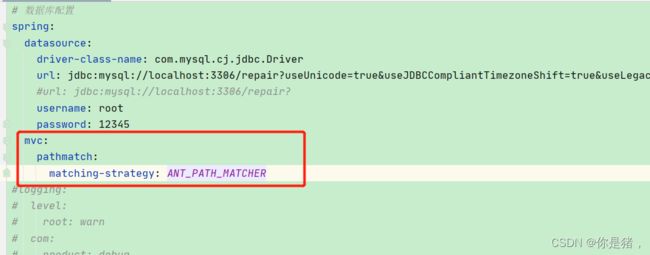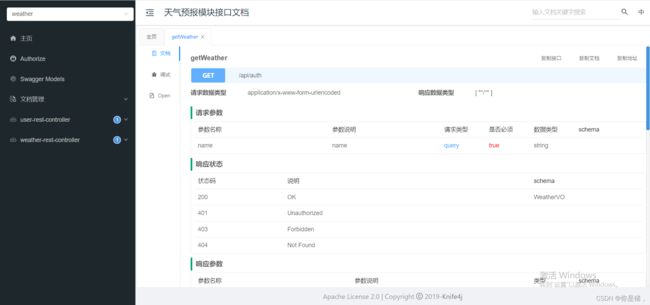knife4j-swagger封装配置,注解使用knife4j
knife4j-swagger
相对于swagger-ui更加的美观,相信大家看到这个界面也就更加肯定我的想法了,比原生的swagger厉害的多了,除了不能进行文件上传接口测试。大家可以去官网进行学习哈。

knife4j的使用
maven引入
com.github.xiaoymin
knife4j-spring-boot-starter
2.0.7
knife4j使用
自定义注解,不懂得人可以复制这段代码,知道自定义注解得可以自己修改使其符合自己得业务。之所以想要使用注解,是因为平时开发时,每次开发一个应用,就要写一些swagger配置类,重复的工作,不如进行简单的封装,只要每次在新的springboot项目上使用注解就可以了。
@Target({ ElementType.TYPE })
@Retention(RetentionPolicy.RUNTIME)
@Documented
@Inherited
@Import({ SwaggerConfiguration.class })//SwaggerAutoConfiguration自己写的配置类
public @interface Swagger2 {
}
knife4j配置
- 首先是配置所需得实体类,当然也可以不用这么多得属性,为了方便,一些信息还是使用配置来进行变更就好了,设定这些默认值都为空字符,注解@Data,可以帮助我们不需要在实体类里写get和set方法。
/**
* swagger配置得实体类
*/
//不需要写get和set方法,会自动给生成,没有需要手动添加get和set方法
@Data
@Component
public class SwaggerProperties
{
/**
* swagger会解析的包路径
**/
@Value("${my-swagger.base-package:}")
private String basePackage = "";
/**
* swagger会解析的url规则
**/
private List basePath = new ArrayList<>();
/**
* 在basePath基础上需要排除的url规则
**/
private List excludePath = new ArrayList<>();
/**
* 标题
**/
@Value("${my-swagger.tittle:}")
private String title = "";
/**
* 描述
**/
@Value("${my-swagger.description:}")
private String description = "";
/**
* 版本
**/
@Value("${my-swagger.version:1.0}")
private String version = "";
/**
* host信息
**/
private String host = "";
/**
* 全局统一鉴权配置
**/
private Authorization authorization = new Authorization();
@Data
public static class Authorization
{
/**
* 鉴权策略ID,需要和SecurityReferences ID保持一致
*/
private String name = "";
/**
* 需要开启鉴权URL的正则
*/
private String authRegex = "^.*$";
/**
* 鉴权作用域列表
*/
private List authorizationScopeList = new ArrayList<>();
private List tokenUrlList = new ArrayList<>();
}
@Data
public static class AuthorizationScope
{
/**
* 作用域名称
*/
private String scope = "";
/**
* 作用域描述
*/
private String description = "";
}
}
- 重点来了,swagger配置类,包含配置请求的头部信息配置,全局借鉴头部信息,使在调试接口时,不需要每次都填写头部内容,过滤认证接口/auth不需要头部信息,过滤springboot自带的/error接口等等,具体来看代码,可直接复制使用:
/**
* 配置类,swagger.enabled参数可以在配置文件中配置,如果为false就不开放文档,这里matchIfMissing给的默认是true
*/
@Slf4j
@Configuration
@EnableSwagger2WebMvc
@EnableAutoConfiguration//自动加载该引用所需得bean。
//@ConditionalOnProperty(name = "swagger.enabled", matchIfMissing = true)//使用knife4j自带的配置,不需要自己来进行设置控制
public class SwaggerConfiguration {
/**
* 默认的排除路径,排除Spring Boot默认的错误处理路径和端点
*/
private static final List DEFAULT_EXCLUDE_PATH = Arrays.asList("/error", "/actuator/**");
private static final String BASE_PATH = "/**";
@Autowired
private ApplicationContext applicationContext;
@Value("${my-swagger.contact.name:}")
private String name;
@Value("${my-swagger.contact.email:}")
private String email;
@Value("${my-swagger.contact.url:}")
private String url;
@Bean
@ConditionalOnMissingBean//确保只有一个
public SwaggerProperties swaggerProperties() {
return new SwaggerProperties();
}
@Bean
public Docket createRestApi(SwaggerProperties swaggerProperties) {
String name = applicationContext.getId();//服务名对应这服务的id
log.info("该应用服务名:{}", name);
//base-path处理
if (swaggerProperties.getBasePath().isEmpty()) {
swaggerProperties.getBasePath().add(BASE_PATH);
}
// noinspection unchecked
List> basePath = new ArrayList>();
swaggerProperties.getBasePath().forEach(path -> basePath.add(PathSelectors.ant(path)));
// exclude-path处理
if (swaggerProperties.getExcludePath().isEmpty()) {
swaggerProperties.getExcludePath().addAll(DEFAULT_EXCLUDE_PATH);
}
return new Docket(DocumentationType.SWAGGER_2)
.apiInfo(apiInfo(swaggerProperties))//api基础信息
.host(swaggerProperties.getHost())//默认是localhost:8080
.select()//选择生成
.apis(RequestHandlerSelectors.basePackage(swaggerProperties.getBasePackage()))//设置哪个包的controller类生成接口
.paths(regex("^.*(? securitySchemes() {
List apiKeyList = new ArrayList();
apiKeyList.add(new ApiKey("Authorization", "Authorization", "header"));
return apiKeyList;
}
/**
* 安全上下文,设置哪些的接口需要进行头部认证,默认排除/auth验证路径
*/
private List securityContexts() {
List securityContexts = new ArrayList<>();
securityContexts.add(
SecurityContext.builder()
.forPaths(regex("^.*(? defaultAuth() {
AuthorizationScope authorizationScope = new AuthorizationScope("global", "accessEverything");
AuthorizationScope[] authorizationScopes = new AuthorizationScope[1];
authorizationScopes[0] = authorizationScope;
List securityReferences = new ArrayList<>();
securityReferences.add(new SecurityReference("Authorization", authorizationScopes));
return securityReferences;
}
private ApiInfo apiInfo(SwaggerProperties swaggerProperties) {
return new ApiInfoBuilder()
.title(swaggerProperties.getTitle())//api名称
.description(swaggerProperties.getDescription())//api文档描述
//.license(swaggerProperties.getLicense())//许可证
//.licenseUrl(swaggerProperties.getLicenseUrl())//许可证url
//.termsOfServiceUrl(swaggerProperties.getTermsOfServiceUrl())//服务条款url
.contact(new Contact(name, url, email))//联系人信息
.version(swaggerProperties.getVersion())//版本号
.build();
}
}
- 路径映射,如果系统做了其他静态资源配置,需要这个类,否则系统能自己找到resources下的静态文件。
/**
* swagger 资源映射路径
*/
@Configuration
public class SwaggerWebConfiguration implements WebMvcConfigurer
{
@Override
public void addResourceHandlers(ResourceHandlerRegistry registry)
{
/** swagger-ui 地址 */
registry.addResourceHandler("/doc.html/**")
.addResourceLocations("classpath:/META-INF/resources/webjars/springfox-swagger-ui/");
}
}
注解的使用
只需要在启动类上使用@swagger注解就可以了,版本原因可能导致出错,请往下看。
@Swagger2
@SpringBootApplication
public class WeatherApplication {
public static void main(String[] args) {
SpringApplication.run(WeatherApplication.class, args);
}
}
- 你以为就可以启动看自己多聪明了嘛,启动时候报错,
org.springframework.context.ApplicationContextException: Failed to start bean
'documentationPluginsBootstrapper'; nested exception is java.lang.NullPointerException
- 解决办法
原因就是knife4j内置得Springfox版本与你使用得Spring Boot起了冲突,因为Springfox使用的路径匹配是基于AntPathMatcher的,而Spring Boot 2.6.X使用的是PathPatternMatcher。
解决起来也很简单:

配置如下:
mvc:
pathmatch:
matching-strategy: ANT_PATH_MATCHER
最后给大家看一下我相关的配置:
#knife4j-swagger配置
knife4j:
# 开启增强配置
enable: true
basic:
enable: true
# Basic认证用户名
username: test
# Basic认证密码
password: 123
#swagger2参数配置
my-swagger:
#基础controller包路径
base-package: com.nchu.weather.controller
#接口文档名称
tittle: 天气预报模块接口文档
#描述
description: 接口文档里的接口都加了基础路径/api,实际前端调用请去掉api
#版本号
version: 2.0
#接口文档联系人
contact:
name: liulaolao
email: [email protected]
url: cafee.top
